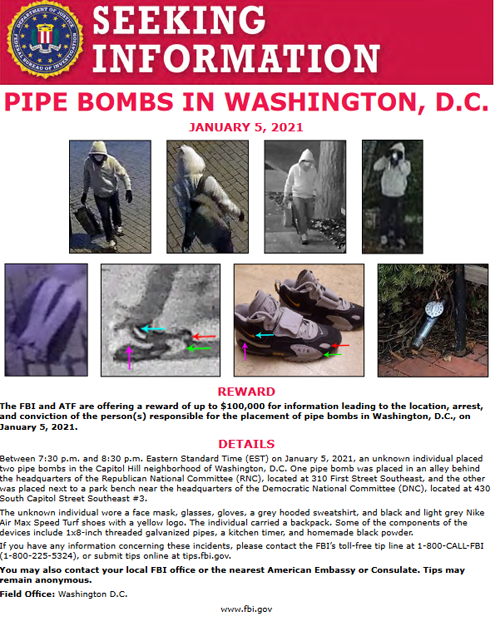As the House Select Committee on the January 6th insurrection by Donald Trump and his allies wraps up, there is hope that some details of the planned coup d’état will be found either in the main report or its appendices. As just one example, the FBI and other law enforcement agencies have not advanced their investigations of who planted pipe bombs at Democratic and Republican National Committee headquarters.
In September last year, the FBI was requesting the public to supply any additional information on the identity of the suspect who planted the bombs. The bureau released video footage of a hooded suspect wearing a backpack placing the pipe bombs on January 5, between approximately 7:30 p.m. and 8:30 p.m., in an area near the House office buildings. Security camera footage showed the suspect first planting a pipe bomb at RNC headquarters at 310 First Street SE and then walking a short distance to a bench at Folger Park near DNC headquarters at 430 South Capitol Street SE, where the second pipe bomb was planted. Based on FBI interviews with residents in the area, there is a strong inclination to believe the pipe bomber was not from the DC area.
The FBI said that the two pipe bombs were of sufficient explosive strength to have seriously injured or killed bystanders had they detonated.
There is other evidence that points to the January 6th insurrectionists having inside help in the Congress, including the offices of the House and Senate Sergeant-at-Arms; the Secret Service; and possibly other federal and local law enforcement agencies.
For example, for reasons yet determined, the emergency panic button located in the office of Representative Ayanna Pressley’s office in the Longworth House Office Building had been removed prior to the January 6th attack. Pressley staffers reported that they had routinely tested the panic button as part of normal emergency drills owing to Pressley, a member of the Democratic “Squad” that includes Alexandria Ocasio-Cortez, having received numerous death threats. There was no information from the House Sergeant-at-Arms office, which is responsible for maintaining the panic buttons, why Pressley’s had been disabled. Pressley told The Boston Globe, “Every panic button in my office had been torn out — the whole unit.” Pressley, her husband, and staff members were barricaded inside the office suite as rampaging seditionists, called to arms by Trump, tore through the Capitol complex. It should be noted that Snopes, which purports to be a fact checking site but is a disinformation conduit, continues to call the removal of panic buttons from Pressley’s office “unproven.”
Another January 6th security issue that is of interest is who disabled Vice President Mike Pence’s access card. which prevented him and his staff from entering the vice president’s office complex in the Capitol, as well as the White House. Pence, his family, staff, and Secret Service detail were forced to huddle in a Capitol loading dock during the ransacking of the Capitol that prevented the certification of the electoral votes for Joe Biden and Kamala Harris. Disabling Pence’s security card could have only been possible with the involvement of the Secret Service. Pence’s access to his Capitol office and the White House was not restored until the evening of January 6th and after the insurrection had been put down.
It will also be interesting what the January 6th report will state concerning the insurrectionists’ pre-knowledge of the location of all the non-reinforced windows and glass-paned doors in the Capitol building. Although most of the 658 windows had been reinforced during a 2017 to 2019 renovation project, certain windows and doors were not and the insurrectionists knew exactly where these vulnerable access points were located, mainly on the west facade where most of the insurrectionists had gathered prior to storming the building.
In addition to these security details, the report will also be examined for any information on suspicious visitor tours of the Capitol conducted on January 5 by Republican members. The tours were unusual since regular tours had been suspended due to the Covid pandemic. The January 5 “tourists” had all been granted access to the Capitol by Republican members or members-elect and were believed to be of a reconnaissance nature by some Democratic House members who had experience with such matters while serving in the military.
With the November 29 convictions for seditious conspiracy being handed down by a Washington, DC, jury for insurrection leaders Stewart Rhodes and Kelly Meggs, the government has established that there was a criminal plot to overthrow the government. Such a predicate will undoubtedly empower the January 6th Committee to identify in its report others who were part of the conspiracy. These could include Republican members of Congress who helped facilitate the siege of the Capitol, as well as members of the Secret Service, congressional staffers, and Trump administration officials, including Trump himself.
Previously published in the Wayne Madsen Report.
Copyright © 2022 WayneMadenReport.com
Wayne Madsen is a Washington, DC-based investigative journalist, author and nationally-distributed columnist. A member of the Society of Professional Journalists (SPJ) and the National Press Club. He is the editor and publisher of the Wayne Madsen Report (subscription required).




A better report here than any I found elsewhere.
The shadowy subterfuge is troubling.